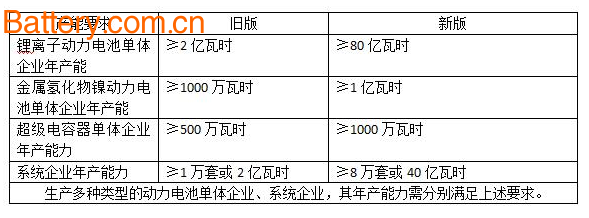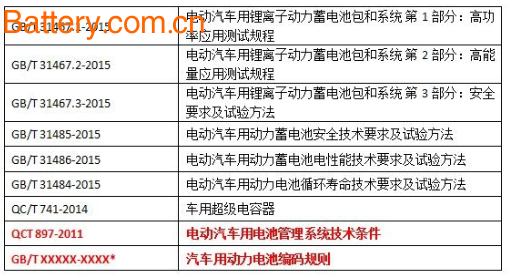Capacity requirements have soared from 200 million watt hours to 8 billion watt hours! Analysis of the 8 major changes in the new version of the power battery industry
 On November 22, the Ministry of Industry and Information Technology issued a notice to publicly solicit opinions on the "Regulations on the Standards of the Automotive Power Battery Industry" (2017). This is the revision of the "Regulations for the Automotive Power Battery Industry" issued in March 2015. After the first electric network, the new version of the draft has 8 major changes compared with the old version. The requirements concerning the production capacity of the enterprise can be described as "great changes."
First, in terms of terminology, changing "power battery" to "power battery" is more in line with industry common language. Its connotation has not changed. It refers to devices used in automobiles that can store and recharge electricity, and provide energy for driving the car, including lithium ion power batteries, metal hydride nickel power batteries and super capacitors . Excluding lead-acid batteries.
Second, the capacity requirements have increased dramatically. The new edition stipulates that the annual production capacity of lithium-ion power battery cells enterprises is not less than 8 billion watt-hours, and the annual production capacity of metal hydride nickel power battery cells enterprises is not less than 100 million watt-hours. The annual production capacity of supercapacitor monomer enterprises is not Less than 10 GWh. The annual production capacity of the system enterprise is not less than 80,000 sets or 4 billion watt hours. Production of various types of power battery cells enterprises, system enterprises, their annual production capacity must meet the above requirements.
Table 1 Comparison of capacity requirements of power battery companies

Comparing the above table, the new version of the annual capacity of lithium battery cells has expanded by 40 times! The annual production capacity of metal hydride nickel battery cells has also increased by 10 times. The capacity requirements of supercapacitor companies are slightly more relaxed and only doubled. The annual capacity requirements of system companies are also very high. According to the research data of Essence Securities, from the perspective of the production capacity of mainstream power battery companies, there are only a handful of standards that can reach the standard. Only BYD, the CATL is just enough to pass the production line at the end of the year.
Table 2 Capacity of domestic mainstream power battery companies

Source: Essence Securities
Third, new security requirements for enterprises. The opinion draft stipulates that the company has not experienced major safety accidents in production and operation and product application in the past two years.
Fourth, in terms of production conditions, two new requirements for monitoring and consistency have been added. First, it must have a "real-time monitoring of the production environment monitoring system." Second, the company should have a standardized process, and establish a complete monitoring system from raw materials, semi-finished products, process parameters of the production process, product delivery, etc., with product consistency assurance capabilities such as process precision control.
Fifth, in terms of technical capabilities, there are two requirements for new equipment and R&D capabilities. First, the company should be equipped with relevant development tools, software, R&D and test verification equipment, and trial production equipment (including pilot lines) that meet at least the above materials analysis, R&D trial production, safety evaluation, and performance evaluation. Secondly, enterprises should have a complete product development experience and have the ability to continuously invest in product development.
Sixth, in terms of product requirements, the power battery products should meet the requirements of the current national standards and industry standards, and pass the qualified automotive power battery related testing institutions to pass the test. Compared with the old version of the policy, the QCT 897-2011 battery management system technical conditions for electric vehicles and GB/T automotive power battery coding rules have been added.
Table 3 List of power battery standards

Seventh, in terms of after-sales service capabilities, the requirements of the new version of the draft are more specific. The company should have the ability to respond quickly to power battery failures, as well as the ability to analyze and analyze power battery usage, failures, and major problems. In addition, the responsibility of battery recycling is not limited to system companies, all power battery companies should meet national and local requirements regarding the recycling of power battery products.
Table 4 Comparison of after-sales service capability requirements of power battery companies

Eighth, there are also minor adjustments in the overall standard management. Enterprises that suspend the qualification of the announcement shall be rectified within a time limit, and if the verification is still not met after the rectification, it shall be revoked from the catalogue. If it is included in the announcement by fraud or bribery and other improper means, it is a matter directly related to security matters, and the application for announcement of the acceptance shall be suspended within 3 years after the cancellation.
Table 5 Comparison of power battery enterprise specification management requirements

Summary: The implementation time of the 2015 version of the automotive power battery specification is not long. It has only been one and a half years since May 1, 2015, but the power battery industry caused by it has changed dramatically. At present, the Ministry of Industry and Information Technology has selected four approved enterprises, a total of 57, 56 single enterprises, and one system enterprise. According to the latest statistics, there are as many as 70 companies applying for it, and foreign power battery companies have not been able to obtain access. For companies that have not yet entered the battery whitelist, the new version of the standard conditional draft has clearly pushed the threshold higher, and the requirement for capacity alone will shut down most companies. Enterprises that have already obtained access can not sit back and relax, and the Ministry of Industry and Information Technology will dynamically manage the catalogue, and it is likely to face retrial. At the end of April this year, after the Ministry of Industry and Information Technology issued the supplementary conditions for the declaration of the power battery catalogue, the first three approved enterprises have made supplementary tests according to the requirements. It seems that it needs to be re-examined and audited. On the whole, the challenges faced by power battery companies in facing policy standards are very serious.
Truck Piston Pin materials are generally low carbon steel or low carbon alloy steel, such as 20, 20 mn, 15Cr, 20 cr or 20 MNV. The outer surface is hardened by carburizing and then refined and polished. This not only improves the surface hardness and abrasion resistance, but also ensures high strength and impact toughness.
Advantage for Truck Piston Pin:Sufficient stiffness, strength and abrasion resistance.

Truck Piston Pin
Truck Piston Pin,Truck Engine Piston Pin,Heavy Duty Truck Piston Pin,Truck Engine Parts Piston Pin
Hebei Zhonghai Shipping Accessories Manufacturing Co., Ltd. , https://www.zhonghaiship.com